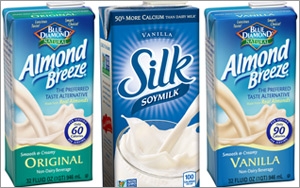food and beverages
'Real' and 'Alternative' Among Key 2016 Food, Beverage Trends
- by Karlene Lukovitz @KLmarketdaily, October 20, 2015

Many of the global food and beverage trends already in play will intensify significantly next year, according to a new report from Mintel.
For instance, "alternative" foods and beverages — items including non-dairy milks and veggie burgers — have gone far beyond being used as substitutes by vegetarians and those with dietary concerns, and now look to create a "profound" change in the marketplace, says Mintel global food and drink analyst Jenny Zegler.
Similarly far-reaching in its effects is the increasingly widespread view of anything artificial as "public enemy No. 1." A growing number of consumers are not only scrutinizing consumables with artificial ingredients; they are shifting their dollars to products with natural formulations with recognizable ingredients.
advertisement
advertisement
Other trends that will exert growing power next year, according to Mintel:
*Imagery helps drive demand: “Flavor has long been the core of innovation, but more visual and sharing-focused societies call for innovation that is boldly colored and artfully constructed," says Zegler. "Finding inspiration in global foodservice offerings, brands can experiment with vibrant colors and novel shapes to make packaged products worthy of consumer praise and social media posts.”
*Good enough to tweet: At the same time, the rise of food-centric media and social media have sparked new interest in cooking for the sake of sharing one's creations with friends. Consumers engaged in this range from those who aspire to compete on cooking shows to those who simply love to experiment with novel recipes and ingredients.
*Fat sheds its stigma: Consumers’ negative stereotype that any and all fat content is evil has begun to diminish, thanks in part to widely covered recent studies. "The awareness of the many sources of good and bad fats is ushering in a paradigm shift in which fat content is not the first and foremost consideration — and barrier — in the search for healthy products," according to Zegler.
*Eating alone loses its stigma: “Across age groups, more consumers are living in single-person households or occasionally eating meals alone," Zegler points out. "These meals for one require right-sized products and packaging, as well as promotions that further erode any stigma of dining solo.”
*Sustainability no longer optional: “Drought, worries about food waste and other natural phenomena not only affect the worldwide food and drink supply, but influence preparation and production," Zegler says. As a result, next year, sustainability will evolve from being good for the bottom line to being a necessary part of new product development for the common good.
*Diet as beauty enhancer: As consumers become more aware that diet affects how they look as well as feel, demand for functional foods and beverages and nutraceuticals enhanced with substances such as collagen and probiotics will only grow stronger.
*Sports nutrition for everyone. “For many, fitness is simply about becoming more active," and as more people do so, there's an opportunity to introduce them to sports nutrition that parallels their activity levels and goals, says Zegler.
*Greater scrutiny of claims: As instances of greenwashing and other deceptions come to light more frequently, consumers (and regulators) will demand more verification of products' origin, ingredients and even inspirational "story" claims (especially mass-produced products).
*Online shopping to see strong growth: Online grocery shopping is still a small percentage of the total in the U.S., but Mintel, along with other experts, believes that it will take a leap forward next year, as options for delivery and pickup proliferate.
*Diet by DNA: While obtaining one's DNA profile isn't likely to become mainstream in 2016, it's not as futuristic as some might think, given declining costs and rising demand. Health and nutrition attitudes are contributors. “Interest in ‘getting back to basics’ has boosted ancient grains and superfoods, fostering a principle that age-old staples are better than today’s manufactured options," says Zegler. "And interest in historical ingredients suggests that consumers could make efforts to unlock the keys to their personal physiology and design diets by connecting with their own ancestry or genetic make-up.”
The Global Food and Drink Trends 2016 report can be downloaded from the Mintel site.




